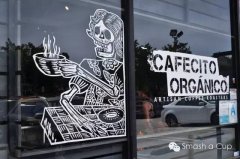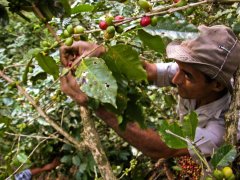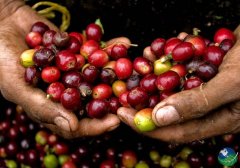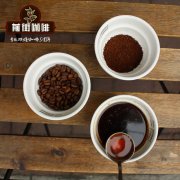Cafecito Learn more about Cafecito
-
Cafecito Organico long queue Cafe

Both Cafecito Organico travelers and westerners come to Los Angeles like to line up in front of Intelligentsia and spend 20 minutes buying a cup of coffee, but Los Angeles locals prefer Cafecito Organico, a much quieter cafe. Here you can relax your nerves, have more personal space and, most importantly, enjoy an addictive Cafe.
2016-06-25 Cafecito Organico Tai Pai long queue Cafe Ca -
Sino-American Coffee | Cuban Coffee producing areas introduce the special flavor of traditional Cuban coffee

Cuba has grown coffee for more than two centuries, including high-quality Arabica coffee varieties. Cuban coffee is usually strong espresso. Traditional Cuban coffee is dark roasted, finely ground coffee, using an espresso machine or mocha pot to make espresso. An important coffee growing area in Cuba is located in Selama Estra in eastern Cuba.
2020-04-27 Central America Coffee Cuba producing area introduction tradition Special Flavor cultivation -
Nestle promotes Cuban Coffee to return to the United States after more than 50 years

Nestl é announced on Monday that it will be the first American company in half a century to sell Cuban coffee in partnership with local Cuban farmers to start selling Nestl é's Cuban coffee this fall under the name Cafecito de Cuba, which will only be used on Nestl é's Nespresso coffee machine. It is reported that this is Cuban coffee that has been away from the United States for more than 50 years.
2016-08-23 Nestl é Promotion Cuba Coffee time interval over years later return United States -
What is Cuban espresso and how does Cuban espresso come from?

Professional coffee knowledge exchange More coffee bean information Please pay attention to coffee workshop (Weixin Official Accounts cafe_style) Origin of Cuban espresso Cafe Cuba (also known as Cuban coffee, Cuban coffee, cafecito) is a type of coffee that originated in Cuba. Specifically, it refers to a sweetened espresso (traditionally stirred with natural brown sugar).
2019-01-19 what cuba espresso coffee how professional knowledge exchange more -
How to make Cuban coffee? Geographical features of Cuba and culture of coffee cultivation, production and consumption

Cuba Geography and Coffee Cultivation: An important coffee-growing region of Cuba is located in the Sierra Maestra Mountains in eastern Cuba. The pleasant climate and fertile reddish-brown soil are rich in humus, so coffee can be grown without fertilizer, giving Cuba a good reputation for growing some of the best coffee. The towns of the Maestra Mountains have a history of growing coffee, people
2020-08-05 how brewing cuba coffee geography style cultivation production consumption culture -
How about Costa Rican coffee with what traditional food? What kind of food do you drink coffee with?

Breakfast starts with a cup of hot coffee, and Costa Ricans like their coffee. The staple food in Costa Rica is rice, beans and vegetables, and they eat almost every meal. On their plates are the famous Gallo pinto, a mixture of rice and beans, as well as white bread, eggs, bananas and rich sour cream. For breakfast, you should know that most Central American coffee
2021-08-05 Costa Rica coffee how about match what tradition food the best breakfast -
Cuban Coffee returns to the United States the flavor characteristics of Cuban coffee describe whether Cuban coffee tastes good

Professional coffee knowledge exchange more coffee bean information please follow the coffee workshop (Wechat official account cafe_style) Cuba coffee exporters are mainly Japan, France, Germany, Ireland and Canada. It is a typical Caribbean style coffee series. Coffee cherries are picked by hand, the maturity is just right, the granules range from 17 to 19 specifications, and are treated with water washing Seiko, with defects.
2019-01-31 Cuba coffee return United States flavor characteristics description delicious -
Mysterious, low-key Cuban coffee flavor

For more information on coffee beans, please follow the history of coffee workshops (official Wechat account cafe_style): the coffee industry in Cuba began in the mid-18th century. The first coffee farm was established by Don Jos Gelabert in Wajay on the outskirts of Havana in 1748. The seeds of coffee came from Santo Domingo at that time, that is, Dominica today.
2018-06-25 Mysterious low-key Cuba coffee taste professional knowledge communication more -
Why Miami Coffee Culture is influenced by Cuba introduction to Miami's unique coffee culture

Miami's coffee culture is inseparable from the influence of Latinos. More than 60 years of Cuban immigration history, unlike most major cities in the United States, has helped to create a culture in a way that enjoys coffee. This means that if you are a roaster or coffee shop that wants to enter this market, you should understand the way people's attitudes towards drinks are shaped. Cuba's contribution to Miami coffee culture
2020-07-06 Why Miami coffee culture will be influenced by Cuba unique introduction -
Introduction to the characteristics of Cuban Coffee producing areas Cuban Coffee Brand recommendation

Professional coffee knowledge exchange more coffee bean information Please follow the coffee workshop (Wechat official account cafe_style) thanks to education, Cuba has created outstanding achievements in literature, art, medicine, biotechnology and other research, and the Cuban government has specially set up various awards to stimulate the labor force. However, when it comes to Cuba's economy, it makes people shake their heads and sigh. The sluggish economy has caused the Cuban people
2019-01-31 Cuba coffee producing area characteristics introduction treatment method brand recommendation -
Coffee cultivation and development in Cuba

Coffee farming in Cuba began in the mid-18th century, with the first coffee farm established by Don Jos Gelabert in Wajay, outside Havana, in 1748. A large number of French and submarine immigrants followed after the outbreak of the Haitian Revolution in 1789.
2017-08-01 Cuba Coffee Plantation and Development Presentation Calendar
